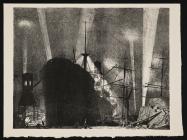The Great War: Britain’s Efforts and Ideals
Items in this story:
The project
The Project was managed by the artist Thomas Derrick (1885–1954), and the printing carried out under the direction of the artist and contributor F. Ernest Jackson (1872-1945). The printer was Avenue Press, London.
The contributing artists were paid well, each receiving £210 (about £10,000 today) with the possibility of further royalties from sales. The prints were a limited edition of two hundred. The ‘Efforts’ were sold for £2 2s 0d (£100) each and the ‘Ideals’ for £10 10s 0d (£500).
As a government commission, the artists did not have full artistic freedom. They were given their subjects and each image had to pass censorship regulations.
The series was first exhibited at the Fine Art Society, London in July 1917, followed by regional art galleries around Britain. It was also shown in France and in America, where the majority of the portfolios were sent to be exhibited and sold.
The portfolio
A series of 66 lithographic prints commissioned by the Ministry of Information in 1917, providing a broad and fascinating representation of Britain’s war objectives, military activities and effort on the Home Front. The most ambitious print project of the First World War, sixty-six prints were produced by the British government in 1917 as artistic propaganda with the aim of encouraging a war-weary public and raising support for the war effort.
Eighteen artists contributed to the series, including some of the most celebrated artists of the time: Augustus John, George Clausen, Frank Brangwyn, Muirhead Bone, Claude Shepperson and Charles Pears.
The prints are divided into two sets of portfolios, ‘Ideals’ and ‘Efforts’
The Ideals
These address the question of why Britain was at war and what it aimed to achieve. These images are dramatic and symbolic, such as The Freedom of the Seas and The Triumph of Democracy. The ‘Efforts’ illustrate some of the activities of the war effort, the means by which Britain was to achieve the ‘Ideals’.
The Efforts
These are separated into ten subject headings, each depicting a different activity or theme: Making Soldiers, Making Sailors, Making Guns, Building Ships, Building Aircraft, Work on the Land, Tending the Wounded, Women's work, Transport by Sea.
Contemporary Reaction to Prints “The very soul of the war is to be read in the set of sixty-six brilliant lithographs.” (The Illustrated London News, 1917) These prints were commissioned as propaganda with the specific aim of raising civilian morale and manipulating public opinion towards the First World War in Britain and abroad. In 1917, after three years of hard fighting and unprecedented loss of life, the government needed a new way to maintain public support for the war. These prints were designed to remind people of the aims and objectives, and emphasise the importance of patriotic duty. It is hard to know whether the prints were successful as propaganda. They were widely published when first exhibited in 1917. Some journalists supported the message, “To see these lithographs is a patriotic as well as an artistic duty” (Burton Daily Mail, Feb 15, 1918). Others were not so positive, “their efforts are in almost every instance sincere; yet the result is, on the whole, meagre and unsatisfying.” (The Daily Telegraph, 20 July 1917). In America, the reaction initially seemed positive, ‘they have been a revelation to American Fifth Avenue art patrons, dealer, critics…They put up British prestige’. However, prints sales there did not meet expectations and a loss was made on the project as a whole.



